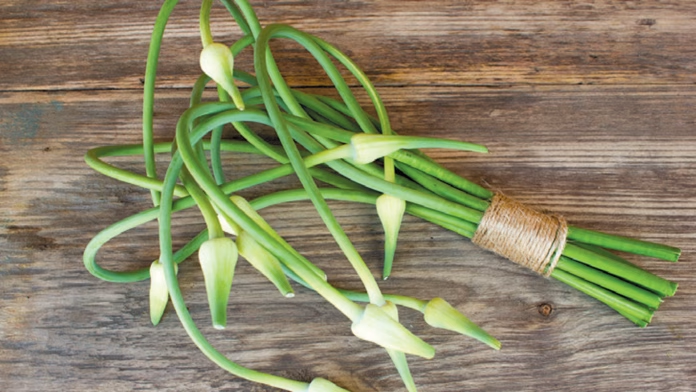Garlic scapes, the long, curly tendrils that grow from the base of hardneck garlic plants, are a culinary treasure waiting to be discovered. They appear at farmers’ markets and well-stocked grocery stores in late spring or early summer and can be used in a variety of ways in cooking. Garlic scapes are less pungent than garlic cloves but still provide a subtle garlicky flavor, making them a versatile ingredient that can be served cooked or raw.
Garlic scapes are often used in hard neck, soups, stir-fries, and salads. They can be sautéed with green beans or other veggies for a side dish or mixed into compound butter or hummus for a quiet kick. Garlic scapes can also be used as a substitute for ramps or leeks in pasta recipes or frittatas. They are best kept in a plastic bag or container in the fridge, where ingredients stay fresh and crunchy for up to three weeks.
Garlic scapes, the long, curly, green shoots that sprout from garlic bulbs, are a versatile and delicious addition to any springtime cooking routine. These flavorful and fragrant vegetables are only available for a short period in the spring and early summer, so it’s important to make the most of them while you can.
Here are 12 creative ways to incorporate garlic scapes to your Diet, particularly during the Spring.
- Garlic Scape Pesto: Garlic scape pesto is a delicious and easy way to use up a large quantity of garlic scapes. Simply blend chopped garlic scapes with olive oil, parmesan cheese, nuts, and salt and pepper to taste. The resulting pesto can be used as a dip, spread, or sauce for pasta or roasted vegetables.
- Garlic Scape Hummus: For a unique twist on classic hummus, blend garlic scapes with chickpeas, tahini, lemon juice, and salt and pepper to taste. This flavorful dip is perfect for snacnumberas a spread on sandwiches and wraps.
- Garlic Scape Butter: Mix chopped garlic scapes with softened butter and salt and pepper to create a flavorful compound butter that can be used to add flavor to grilled meats, roasted vegetables, or even toast.
- Garlic Scape Aioli: Blend garlic scapes with mayonnaise, lemon juice, and salt and pepper to create a flavorful aioli that can be used as a dip, spread, or sauce for sandwiches or roasted vegetables.
- Garlic Scape Soup: Use garlic scapes as the base for a flavorful soup by sautéing them with onions and other vegetables, adding broth and spices, and simmering until tender. Puree the soup for a smooth and creamy texture.
- Garlic Scape Salad Dressing: Blend garlic scapes with olive oil, vinegar, honey, and salt and pepper to create a flavorful and tangy salad dressing that pairs well with mixed greens, roasted vegetables, or grain bowls.
- Grilled Garlic Scapes: Brush garlic scapes with olive oil and grill until tender and slightly charred for a delicious and easy side dish.
- Garlic Scape Chimichurri: Blend garlic scapes with fresh parsley, olive oil, red wine vinegar, and red pepper flakes to create a tangy and flavorful chimichurri sauce that pairs well with grilled meats and roasted vegetables.
- Garlic Scape Frittata: Sautee garlic scapes with other vegetables and eggs to create a flavorful and protein-packed frittata that can be enjoyed for breakfast, lunch, or dinner.
- Garlic Scape Stir Fry: Stir fry garlic scapes with other vegetables, tofu, or protein, and your favorite sauce for a flavorful and healthy meal.
- Garlic Scape Pizza: Use garlic scape pesto or chopped garlic scapes as a topping for homemade pizza, along with your favorite cheeses and other toppings.
- Garlic Scape Salsa: Blend garlic scapes with diced tomatoes, red onion, jalapeno, lime juice, and salt and pepper to create a flavorful and unique salsa that pairs well with tortilla chips, grilled meats, or roasted vegetables.
By experimenting with these 12 creative ways to use garlic scapes, you can elevate your springtime meals and take advantage of the brief season when these tasty vegetables are at their peak.
Garlic scapes are a seasonal ingredient, so be sure to take advantage of them while they’re available. These twelve ideas are just the beginning, so don’t be afraid to experiment and discover new ways to use this flavorful and unique ingredient in your cooking.




